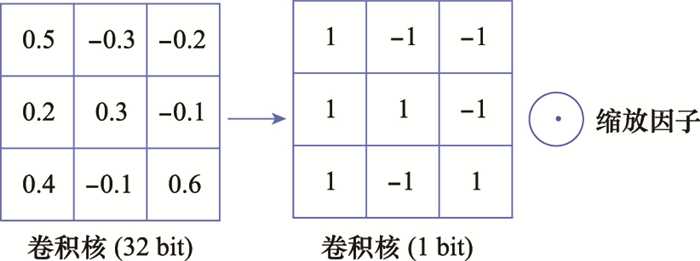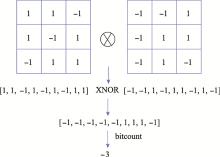Systems Engineering and Electronics ›› 2024, Vol. 46 ›› Issue (11): 3912-3919.doi: 10.12305/j.issn.1001-506X.2024.11.33
• Communications and Networks • Previous Articles Next Articles
Radiation source signal recognition method based on binary neural networks
Huifu WANG1,2, Mingfei MEI1,2, Liang QI2, Heng CHAI3, Shifei TAO1,*
- 1. School of Electronic and Optical Engineering, Nanjing University of Science and Technology, Nanjing 210094, China
2. Nanhu Laboratory, Jiaxing 314000, China
3. 723 Research Institute, Shipbuilding Group Limited of China, Yangzhou 225000, China
-
Received:2023-07-31Online:2024-10-28Published:2024-11-30 -
Contact:Shifei TAO
CLC Number:
Cite this article
Huifu WANG, Mingfei MEI, Liang QI, Heng CHAI, Shifei TAO. Radiation source signal recognition method based on binary neural networks[J]. Systems Engineering and Electronics, 2024, 46(11): 3912-3919.
share this article
Table 1
Simulation parameters for each signal"
| 信号类型 | 参数 | 取值范围 |
| CW | 载频fc | [1/8, 3/8]fs |
| LFM | 起始频率f0 | [1/16, 3/16]fs |
| EQFM | 带宽B | [1/16, 3/16]fs |
| SFM | 起始频率f0 | [1/16, 3/16]fs |
| 带宽B | [1/20, 1/10]fs | |
| COSTAS | 基准频率f0 | [1/40, 1/4]fs |
| 跳频序列NF | {4, 5, 6} | |
| BPSK | 载频fc | [1/16, 3/16]fs |
| 巴克码长度 | {5, 7, 11, 13} | |
| LFM_FSK | 基准频率f0 | [1/40, 1/4]fs |
| 子码带宽B | [1/40, 1/20]fs | |
| LFM_SFM | 起始频率f0 | [1/16, 3/16]fs |
| 带宽B | [1/16, 3/16]fs |
| 1 |
YANG H H , YANG X P , LIU S K , et al. Radar emitter multi-label recognition based on residual network[J]. Defence Technology, 2022, 18 (3): 410- 417.
doi: 10.1016/j.dt.2021.02.005 |
| 2 |
刘赢, 田润澜, 王晓峰. 基于深层卷积神经网络和双谱特征的雷达信号识别方法[J]. 系统工程与电子技术, 2019, 41 (9): 1998- 2005.
doi: 10.3969/j.issn.1001-506X.2019.09.12 |
|
LIU Y , TIAN R L , WANG X F . Radar signal recognition method based on deep convolutional neural network and bispectral features[J]. Systems Engineering and Electronics, 2019, 41 (9): 1998- 2005.
doi: 10.3969/j.issn.1001-506X.2019.09.12 |
|
| 3 |
MUHAMMAD Y S , WANG J H , XV M M , et al. Ship detection based on deep learning using SAR imagery: a systematic literature review[J]. Soft Computing, 2023, 27 (1): 63- 84.
doi: 10.1007/s00500-022-07522-w |
| 4 | YAO Y , WANG Z H . Radar signal recognition based on time-frequency and CNN preprocessing[J]. Journal of Detection and Control, 2018, 40 (6): 99- 105. |
| 5 |
SHI L M , YANG C Z . Recognition method of radar signal mo-dulation method based on deep network[J]. Journal of Ordnance Equipment Engineering, 2021, 42 (6): 190-193, 218.
doi: 10.11809/bqzbgcxb2021.06.033 |
| 6 |
崔邦彦, 田润澜, 王东风, 等. 基于注意力机制和改进CLDNN的雷达辐射源识别[J]. 系统工程与电子技术, 2021, 43 (5): 1224- 1231.
doi: 10.12305/j.issn.1001-506X.2021.05.09 |
|
CUI B Y , TIAN R L , WANG D F , et al. Radar emitter identification based on attention mechanism and improved CLDNN[J]. Systems Engineering and Electronics, 2021, 43 (5): 1224- 1231.
doi: 10.12305/j.issn.1001-506X.2021.05.09 |
|
| 7 |
GAO J P , WANG X , WU R W , et al. A new modulation recognition method based on flying fish swarm algorithm[J]. IEEE Access, 2021, 9, 76689- 76706.
doi: 10.1109/ACCESS.2021.3079131 |
| 8 | TAO S F , XIAO S , GONG S , et al. Recognition of electromagnetic signals based on the spiking convolutional neural network[J]. Wireless Communications and Mobile Computing, 2022, 2022, 2395996. |
| 9 | MUHAMMAD U, LEE J A. AMC-IoT: automatic modulation classification using efficient convolutional neural networks for low powered IoT devices[C]//Proc. of the International Confe-rence on Information and Communication Technology Convergence, 2020: 288-293. |
| 10 | WANG T Y, JIN Y H. Modulation recognition based on lightweight neural networks[C]//Proc. of the 13th International Congress on Image and Signal Processing, BioMedical Engineering and Informatics, 2020: 468-472. |
| 11 |
ZHANG F X , LUO C B , XV J L , et al. An efficient deep learning model for automatic modulation recognition based on parameter estimation and transformation[J]. IEEE Communications Letters, 2021, 25 (10): 3287- 3290.
doi: 10.1109/LCOMM.2021.3102656 |
| 12 |
WANG N , LIU Y X , MA L , et al. Multidimensional CNN-LSTM network for automatic modulation classification[J]. Electronics, 2021, 10 (14): 1649.
doi: 10.3390/electronics10141649 |
| 13 | 权宇, 李志欣, 张灿龙, 等. 融合深度扩张网络和轻量化网络的目标检测模型[J]. 电子学报, 2020, 48 (2): 390- 397. |
| QUAN Y , LI Z X , ZHANG C L , et al. Fusing deep dilated convolutions network and light-weight network for object detection[J]. ACTA Electonica Sinica, 2020, 48 (2): 390- 397. | |
| 14 | WANG Z W, ZHENG Q, LU J W, et al. Deep hashing with active pairwise supervision[C]//Proc. of the European Confe-rence on Computer Vision, 2020: 522-538. |
| 15 | WANG Z W, XIAO H, LU J W, et al. Generalizable mixed-precision quantization via attribution rank preservation[C]//Proc. of the IEEE/CVF International Conference on Computer Vision, 2021: 2-9. |
| 16 | GONG R H, LIU X L, JIANG S H, et al. Differentiable soft quantization: bridging full-precision and low-bit neural networks[C]//Proc. of the IEEE/CVF International Conference on Computer Vision, 2019: 4852-4861. |
| 17 | YANG J W, SHEN X, XING J, et al. Quantization networks[C]// Proc. of the IEEE/CVF Conference on Computer Vision and Pattern Recognition, 2019: 7308-7316. |
| 18 | ULLRICH K, MEEDS E, WELLING M, et al. Soft weight sharing for neural network compression[C]//Proc. of the International Conference on Learning Representations, 2017. |
| 19 | ZHANG D Q, YANG J L, YE D Q, et al. LQ-nets: learned quantization for highly accurate and compact deep neural networks[C]//Proc. of the European Conference on Computer Vision, 2018: 365-382. |
| 20 | QIN H T , GONG R H , LIU X L , et al. Binary neural networks: a survey[J]. Pattern Recognition, 2020, 105, 1737- 1746. |
| 21 | CHEN T L, ZHANG Z Y, OUYANG X, et al. "BNN-BN=?": training binary neural networks without batch normalization[C]//Proc. of the IEEE/CVF Conference on Computer Vision and Pattern Recognition, 2021: 4619-4629. |
| 22 | SHEN Z Q, LIU Z C, QIN J, et al. S2-BNN: bridging the gap between self-supervised real and 1-bit neural networks via guided distribution calibration[C]//Proc. of the IEEE/CVF Conference on Computer Vision and Pattern Recognition, 2021: 2165-2174. |
| 23 |
XUE P , LU Y , CHANG J F , et al. Self-distribution binary neural networks[J]. Applied Intelligence, 2022, 52 (12): 13870- 13882.
doi: 10.1007/s10489-022-03348-z |
| 24 |
WANG Z W , LU J W , WU Z Y , et al. Learning efficient binarized object detectors with information compression[J]. IEEE Trans. on Pattern Analysis and Machine Intelligence, 2022, 44 (6): 3082- 3095.
doi: 10.1109/TPAMI.2021.3050464 |
| 25 | JI H, XU W Y, GAN L, et al. Modulation recognition based on lightweight residual network via binary quantization[C]//Proc. of the 7th International Conference on Computer and Communications, 2021: 154-158. |
| 26 | RASTEGARI M, ORDONEZ V, REDMON J, et al. Xnor-net: imagenet classification using binary convolutional neural networks[C]//Proc. of the European Conference on Computer Vision, 2016: 525-542. |
| 27 |
HUANG D K , YAN X P , HAO X H , et al. Low SNR multi-emitter signal sorting and recognition method based on low-order cyclic statistics CWD time-frequency images and the YOLOv5 deep learning model[J]. Sensors, 2022, 22 (20): 7783.
doi: 10.3390/s22207783 |
| 28 | 肖帅, 龚帅阁, 李想, 等. FPGA平台轻量化卷积神经网络辐射源信号识别方法[J]. 计算技术与自动化, 2023, 42 (4): 140- 146. |
| XIAO S , GONG S G , LI X , et al. Emitter signal identification method with lightweight CNN on FPGA platform[J]. Computing Technology and Automation, 2023, 42 (4): 140- 146. | |
| 29 | PAVLO M, STEPHEN T, TERO K, et al. Pruning convolutional neural networks for resource efficient inference[EB/OL]. [2023-05-31]. https://arxiv.org/abs/1611.06440. |
| 30 | BOYD S , PARIKH N , CHU E , et al. Distributed optimization and statistical learning via the alternating direction method of multipliers[J]. Foundations and Trends in Machine Learning, 2011, 3 (1): 1- 122. |
| 31 | 王子为, 鲁继文, 周杰. 基于自适应梯度优化的二值神经网络[J]. 电子学报, 2023, 51 (2): 257- 266. |
| WANG Z W , LU J W , ZHOU J . Learning adaptive gradients for binary neural networks[J]. ACTA Electonica Sinica, 2023, 51 (2): 257- 266. |
| [1] | Dongsheng ZHU, Xiaojing SU, Zhixun MA, Yingjie SHI. Design of adaptive detector for inhomogeneous clutter background [J]. Systems Engineering and Electronics, 2024, 46(11): 3613-3620. |
| [2] | Jian GUAN, Xingyu JIANG, Ningbo LIU, Hao DING, Yong HUANG. Dual-polarized maximum eigenvalue-based target detection in sea clutter environment [J]. Systems Engineering and Electronics, 2024, 46(11): 3715-3725. |
| [3] | Zhian DENG, Zhiguo WANG, Sheng'ao WANG, Weijian SI. Radar signal modulation recognition method based on synchro-extracting transform denoising [J]. Systems Engineering and Electronics, 2024, 46(10): 3334-3346. |
| [4] | Jingyuan SHAN, Yu LU, Hanyu LING. Robust adaptive multi-target tracking algorithm for airborne passive bistatic radar [J]. Systems Engineering and Electronics, 2024, 46(9): 2902-2915. |
| [5] | Xin YANG, Kaizhi RUAN, Hongming LIU, Xiaoke WANG, Jingqiu LIU, Yusheng SHI. Anti-bias track association algorithm based on target measurement error distribution [J]. Systems Engineering and Electronics, 2024, 46(8): 2820-2828. |
| [6] | Yiqiong YANG, Jianxin WU, Yi LIANG. Airborne bistatic radar beam domain clutter suppression method [J]. Systems Engineering and Electronics, 2024, 46(6): 1935-1945. |
| [7] | Jianjie QIU, Yichao CAI, Hao LI, Quanyin HUANG. Grey theory track association algorithm based on dynamic estimation feedback [J]. Systems Engineering and Electronics, 2024, 46(4): 1401-1411. |
| [8] | Weijian SI, Yue ZHANG, Zhian DENG. Connected k-nearest neighbor clustering algorithm for radar signal sorting [J]. Systems Engineering and Electronics, 2023, 45(8): 2463-2470. |
| [9] | Yali NIU, Jingwei XU, Guisheng LIAO, Qingyun KAN, Guangjun LIU. Clutter suppression approach for missile-borne HPRF radar with sum-difference antenna [J]. Systems Engineering and Electronics, 2023, 45(8): 2455-2462. |
| [10] | Zhikai LIN, Weijian LIU, Lichang QIAN, Binbin LI, Bilei ZHOU, Zhaojian ZHANG, Hao CHEN. A weighted adaptive detector for mismatched subspace signal detection [J]. Systems Engineering and Electronics, 2023, 45(7): 1974-1980. |
| [11] | Tao CHEN, Fuyue LIU, Jinxin LI, Yu LEI. End-to-end radar signal sorting based on deep segmentation [J]. Systems Engineering and Electronics, 2023, 45(5): 1351-1358. |
| [12] | Xiang FENG, Fengcong LI, Yu FAN, Tao LIU, Wenqing CUI, Yinan ZHAO. Radar composite waveform design with low range sidelobes based on particles sampling projection [J]. Systems Engineering and Electronics, 2023, 45(4): 1008-1015. |
| [13] | Zhixing LIU, Yinghui QUAN, Minghui SHA, Wen FANG, Xia GAO, Mengdao XING. Target parameter estimation method for frequency agility and pulse repetition frequency agility radar [J]. Systems Engineering and Electronics, 2023, 45(2): 401-406. |
| [14] | Xin LI, Xiaoyun XIA, Yushi ZHANG, Penglang SHUI. RCS estimation and characteristic analysis of weak target under sea background [J]. Systems Engineering and Electronics, 2023, 45(2): 424-430. |
| [15] | Yu LEI, Xiangguang LENG, Xiaoyan ZHOU, Zhongzhen SUN, Kefeng JI. Recognition method of ship target in complex SAR image based on improved ResNet network [J]. Systems Engineering and Electronics, 2022, 44(12): 3652-3660. |
| Viewed | ||||||
|
Full text |
|
|||||
|
Abstract |
|
|||||











